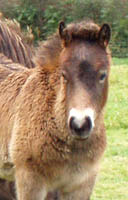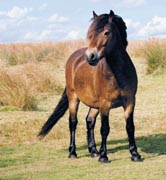| 'Moor to Offer' - by Dawn Williams - feature from Your Horse Magazine (Oct/Nov 06 issue) |
Gone is the shaggy moorland image of old, as Exmoors emerge as quality riding ponies. If you've never considered owning or riding one before, prepare to change your mind.
Nothing could survive the wilds of Exmoor for 100,000 years-plus without adapting to be tough, hardy and quick-witted, and the versatile Exmoor pony is all this and more. Shrugging off its tricky to handle, moorland pony image, the breed is emerging as an intelligent, independent all-rounder, attracting the attention of children and adults who want a family pony for hacking, showing and jumping.
With increased interest in natural horsemanship, more people are unlocking the secrets of these unique ponies and realising the value of working with them. Over recent years, the entries in Exmoor in-hand and ridden classes have swelled and judges regularly comment on their condition, quality of movement , intelligence and trainability
The question is, how do you work with an Exmoor? Naturally bright and independent they may be, but you can't force them to do anything they don't want to do. They'll question any activity they consider to be unfair or unreasonable and have a startling capacity to ask 'why?'. The key to working with Exmoor ponies is to win their trust, friendship and respect by learning to speak 'equus' (the listening and commonsense approach to horses used by good stockmen for centuries).
|
|
From groundwork to ridden work, the Exmoor requiries clear, reasonable and fair handling 100% of the time. This also applies to Exmoors born in studs. They'll instinctively look for that fairness of handling - and still have a unique element of 'the moor' in them. The ponies versatility extends to their weight carrying capabilities too. Exceptionally strong and well put together, they can easily carry up to 12 stones.
A Rare Sight
Despite their growing popularity, Exmoors are an endangered breed, with only about 2,500 ponies in the world. This is a great achievement, however, as after the Second World War, there were just four registered stallions and 50 ponies left. A group of breeders got together and carefully managed this tiny gene pool to save the breed from extinction.
Today, there are about 29 mare lines and it's essential that the most is made of the entire gene pool to ensure maximum health and quality of the breed in the future. Once a mare line is lost, vital DNA is also lost, as this can only be passed on through the mare lines. It's also important that a wide range of quality stallions is used with their varied genes - some of which are recessive, hiding desirable characteristics that can reappear in later generations.
Each year, the small moorland herds are gathered in the autumn and brought in for inspection and branding. The Exmoor Pony Society registers every pony who passes the inspection and it's this careful process that ensures the breed stays pure and true to its type.
Branding is also used so the ponies can be identified and recognised, and is essential for the safety and security of those returned to the moor. Only skilled Exmoor Pony Society Inspectors are allowed to do it, with great care taken to ensure it's done properly.
Life on the Moor
There is a strict grazing quota in the moorland areas of Exmoor and some of the youngstock, particularly the colts, can't be turned back out onto the moor and must find a new home and a life of domesticity. This is a challenging journey for youngsters to make as the survival instincts of free-living herds are enhanced.
They're highly sensitive and ready to take flight at the slightest perceived danger. When faced with human contact, this might be as simle as the merest twitch of a finger - and jerky or sudden movements can cause outright panic in the initial stages of training. This misconception can be to assume a 'wild' pony has suffered trauma - when in fact, he's simply not used to people.
It's this
sensitivity that poses breeders with a problem each autumn as they try to find homes for moor-bred colts and fillies. While many of the youngsters are snapped up by enthusiasts as foals, or kept by breeders to develop as breeding or performance ponies, the remainder are reliant on finding new owners whose horsemanship skills are up to the requirements needed.
Showing Success
Many children and adults enjoy success with Exmoor ponies and all of them acknowledge the importance of building a partnership to achieve the best from them. During 2006, the Exmoor Pony Musical Ride team has been a hit at shows and events. It's organised by Exmoor breeders Yvonne Campbell, Anne Whittle and Jo Gingell (with the help of Marian Williams and Irene Nash). The team's trainers is mounted police officer, John Green.
Five of the eight ponies in the original line-up were bred on the moor, and the team performed at the TREC European Championships in September.
"Preparing highly sensitive ponies to cope with close-formation riding and crowds has been a challenge," says Anne Whittle. "It's taken a fair bit of training and a lot of laughs, but I've been delighted at how well the ponies have adapted. They hear the music and off they go, and you can use faster music with Exmoors because their paces are shorter."
Hawkwell Hercules is the senior member of the team at 18. "He's done everything and been incredible," says Anne. "He takes part in showing, dressage, endurance rides and breed displays. "We set up the Musical Ride to promote Exmoors and generate interest in the ponies. There's no reason why they can't do everything other horses do." A sentiment echoed by Exmoor pony fans everywhere!
|
|
| CASE STUDY ONE: Exmoor colt Hawkwell Versuvius 'Exmoors Have Taught Me So Much' |
When Dawn Wlliams got involved with Exmoors three years ago, she threw her text books out of the window. "I realised that no book went into the depth of communication I needed to work with an Exmoor straight off the moor. I had to start from scratch, and the ponies quickly showed me that I knew nothing."
Once colt in particular, Bear (breed name Hawkwell Versuvius), was highly sensitive and always stood behind the others, refusing to be touched and taking flight at the slightest movement - and through whatever was in his path.
"Bear had us scratching our heads," says Dawn. "We couldn't touch him and had to re-learn our whole approach - body language, advance and retreat, feel, timing and balance. Bear's an incredible teacher and refused to deal with us until we approached him in an acceptable way. Yes, we could have forced the issue at that point, but I sensed we'd achieve more in the long-term if we took the trouble to learn from him. With an Exmoor, you need to find new reserves of patience before they give you their trust."
A few weeks after accepting his first headcollar, Bear allowed Dawn and her yard manager, Caroline Tout, to introduce him to in-hand schooling, grooming and loading. "Once our approach had reached the standard Bear demanded, he started to trust us and we were able to quickly progress."
Withing four weeks of wearing his first headcollar, we took Bear to the Exmoor Pony Society Christmas Show and he won two classes. Bear (Hawkwell Versuvius) has since been crowned Supreme Champion at the 2006 Exmoor Pony Society Breed Show and is now a licensed stallion (at just 2 years old).
"Bear's progressing well because we've listened to him and enabled him to develop confidence through trust-based methods of training. As we've learned to communicate with Bear, it's given him the confidence to face large crowds, noise , lorry parks and county show rings - and he's a natural showman!"
Further reading: CLICK HERE for Hawkwell Versuvius' web page
Further reading: CLICK HERE for the Hawkwell Herd 12 Breeders web page
Captions: From top: Hawkwell Versuvius as a foal, newly arrived; one of his first in-hand schooling sessions as a yearling; playing with his fieldmate, Boy Harry; rearing at the May 2006 EPS Stallion Parade; winning Champion Exmoor at Devon County 2006; Supreme Champion at the 2006 Exmoor Pony Society Breed Show, Exford.
|
|
| CASE STUDY TWO: 'We've Ridden and Bred Exmoors for 30 Years' - Ruth & Dai Thomas Coed-y-Wern Herd |
Dai & Ruth Thomas, both vets, have been riding and breeding Exmoor ponies for more than 30 years. They're based in Wales and have miles of beautiful riding countryside close by inthe Brecon Beacons National Park.
"We got involved with Exmoors when we were at vet college in Edinburgh in the 1960s," says Ruth. "Exmoors were used for pony trekking in the Borders of Scotland over the summer months and the students were responsible for handling and breaking them in. Treks of 10 or so ponies were taken out daily, carrying young people and adults for up to 20 miles. There were no problems with ponies carrying adults over the hills.
"Since then, we've continuously bred Exmoors (the Coed-y-Wern herd) and ride them for pleasure over the hilly countryside where we live in mid Wales. Every autumn we organise a Welsh Area Exmoor Pony Society ride, where Exmoor pony owners, mostly adults, come with their ponies for an enjoyable day's riding.
" A strong, fit Exmoor pony is capable of carrying an adult without a problem, as their sturdy conformation and strong bones make them ideal for weight carrying. Wide nostrils and nasal passages and barrel-shaped chests enable efficient respiration, and their economical action makes them suitable for covering rough ground. They are well suited to endurance riding and TREC competitions because of their stamina.
"I ride Yarrow, my 12 year old mare, and find Exmoor ponies are very easy to do. There are some rough bits of ground here and they're much better suited than horses for this type of country. Exmoors are very sure-footed and safe to ride, and older adult riders find an Exmoor much easier to get on and off than a horse!" |
Ruth & Dai Thomas riding Coed-y-Wern Herd Exmoor ponies
|
| How to Spot an Exmoor Pony... |
Exmoor Pony Body: Exmoor ponies are substantially built with a wide, barrel-shaped body, a deep chest, hard feet, stocky legs and plenty of bone. With an average height of just 12.1hh, they can easily carry riders up to 12 stones.
Exmoor Pony Colours: Varying shades of dun, brown and bay, with mealy muzzles and mealy colourings around their eyes, under their bellies and inside their hind legs.
Coat: Short and glossy in summer, with a thick winter coat that has an inner layer of soft, woolly hair for warmth and an outer layer of longer 'guard' hairs to repel water and keep them dry.
Head: This is short and broad across the muzzle, witha good width between the eyes and small ears.
Teeth: The ponies large, well-rooted teeth are set into a deep jaw bone for effective grinding up of coarse vegetation. Plier-like incisors can bit off even very short grass.
Movement: Exmoor ponies have a long, low stride, giving easy movement over rough terrain and a well-balanced ride. Short cannon bones mean they're strong and sure-footed. They should track up in walk and trot.
Types of Exmoor pony: There are several 'types' of Exmoors and each herd has its own characteristics. For example, there is the Anchor type with its distinct markings; the Hawkwell, with its beautiful head, large eyes and outstanding movement, and the red-coloured Milton and Knightoncombe types. The Milton (Herd 23) ponies have exceptional 'toad' eyes.
Home: Exmoor, which straddles Somerset and Devon. (There are also herds around the UK, including Scotland, and overseas in Sweden and Germany.)
|

 Herd 23 stallion, Prince Harry II
Herd 23 stallion, Prince Harry II
|
|
|